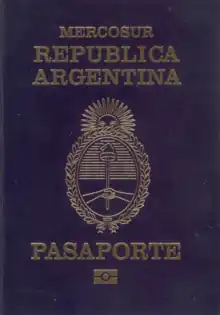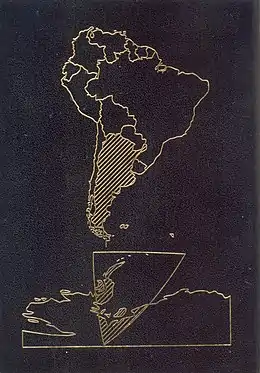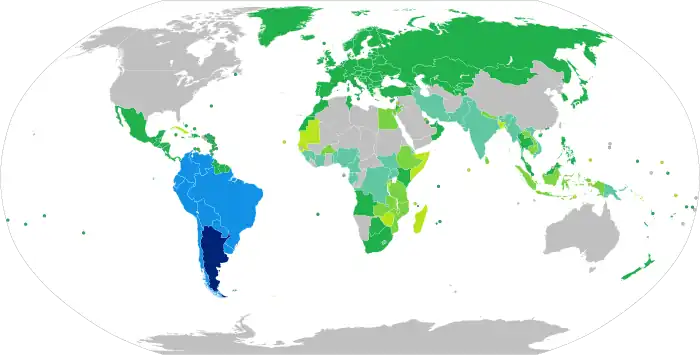| |
|---|---|
 The front cover of the current biometric Argentine passport, featuring its purple cover. | |
 | |
| Type | Passport |
| Issued by | |
| First issued | 2018[1] (current version) |
| Purpose | Identification |
| Eligibility | Argentine citizenship |
| Expiration | 5 years after issuance (people aged 0-17) or 10 years after issuance (people 18 or older) |
| Cost | [2] |
Argentine passports (Spanish: Pasaporte argentino) are issued to citizens of Argentina by the National Registry for People (ReNaPer). They were issued exclusively by the Argentine Federal Police up to 2011. Their primary use is to facilitate international travel.
Argentine passports are valid for travel all over the world, but some countries require a visa. For traveling within South America (except the Guyanas, Suriname, and european depencies), Argentines do not need to use a passport, as they may use their National Identity Document (DNI).[3]
On June 15, 2012, the Argentine Interior Ministry announced the immediate introduction of biometric passports. The new passports have unique numbers (alphanumerical combinations, with 3 letters and 6 numbers), a significant change from the previous policy, where passport numbers were the national ID number of the holders (with an N after it). Since December 2012, all new Argentine passports are biometric passports.[4]
As of 11 January 2022, Argentine citizens had visa-free or visa on arrival access to 170 countries and territories, ranking the Argentine passport 19th in terms of travel freedom. The Argentine passport is the 2nd most powerful passport in Latin America after the Chilean passport and is the 4th most powerful overall in the Americas, according to the Henley Passport Index.[5]
Additionally, an "Exceptional passport for foreigners" can be issued in Argentina to non-citizens who cannot obtain their national passport. This exceptional passport is identical to those issued to Argentine nationals, without any discernible differences in its appearance or features.[6] This unique provision ensures that foreign residents in Argentina who face difficulties in obtaining their home country's passport have a valid travel document that is on par with the regular Argentine passport.
Bureaucracy
In accordance with Presidential Decree 2015–66, in order to get an Argentine passport, a person must go to the nearest civil registry office and present his/her national identity document, birth certificate and a proof of marital status (unless single). If the person is an Argentine citizen by naturalisation rather than by birth, a citizenship certificate (carta de ciudadanía) must also be presented. Citizens under the age of 18 may get a passport only with parental authorization. Argentines living outside the country must follow the same procedure at an Argentine embassy or consulate.
The regular passport price is 15,000 ARS. Applicants usually receive their passports via postal mail within 15 days. There is an express service (48–96 hours) for 30,000 ARS, a 24-hour passport for 45,000 ARS, and an ultrafast passport for 75,000 ARS at airports (6 hours), with the possibility of getting a passport, if there are any proofs (as a printed ticket) of an international flight for that same day.[2]
Since January 2011, Argentine passports are valid for 10 years. Beforehand, they were valid only for 5-year periods.
Passports are not issued to persons who are under arrest because of criminal offenses, or to those labeled 'dangerous' as per the South American Police Agreement of 1920.
Regular passport
In accordance with Mercosur regulations, it is blue-covered, with the legend MERCOSUR written on its top, followed by the country's

name in Spanish (REPÚBLICA ARGENTINA), the national coat of arms and the word PASAPORTE (Passport). A biometric passport has the e-passport symbol at the bottom.
It has a data page with a machine-readable zone and a digital photograph of the passport holder. All the information is written in Spanish and English.
- Photograph
- Type of document (P for Passport)
- Country code (ARG)
- Passport number
- Surname
- Given names
- Nationality
- Date of Birth
- DNI number (known officially in English as “personal number”)[7]
- Gender
- Place of birth (Province and country code)
- Issuing date
- Expiration date
- Signature
- Fingerprint
The previous version also included:
- Passport copy (i.e., the number of passports the bearer had before the current one)
- Marital status
- Police-registry Number

A map of South America appears on the back of Argentine passports, showing the country's location within the continent, with the Falkland Islands and the Argentine Antarctic Claim (Antártida Argentina).
Passport message
Passports of many countries contain a message addressed to authorities of other countries identifying the bearer as a citizen of the issuing country, requesting that he or she be allowed to enter and pass through the other country, and requesting that, when necessary, he or she be given assistance consistent with international norms. In Argentine passports, the message is in Spanish, English, Portuguese and French. The message is:
In Spanish:
- En nombre del Gobierno de la República Argentina, la autoridad que expide el presente pasaporte ruega y solicita a todos aquellos a quienes puede concernir, dejen pasar libremente a su titular y prestarle la asistencia y protección necesaria.
In English:
- The Government of the República Argentina hereby requests all whom it may concern, to permit the bearer to pass without delay or hindrance and in case of need, to give all lawful aid and protection.
In Portuguese:
- Em nome do Governo da República Argentina, a autoridade que concede o presente passaporte roga e solicita às autoridades competentes, deixar passar livremente o titular e prestar-lhe toda a assistência e proteção necessária.
In French:
- Au nom du Gouvernement de la République Argentine, l'autorité qui délivre le présent passeport demande à tous ceux qui pourraient être concernés, de laisser passer librement son titulaire et lui prêter l'assistance et la protection nécessaire.
Required Documents to Apply for Passport in Argentina
Individuals applying for an adult passport in Argentina need to adhere to specific document requirements. The following outlines the necessary documents for those aged 18 and above:
- Valid DNI Card: A current, valid DNI (Documento Nacional de Identidad) card is required.
- Previous Passport (Recommended but Not Mandatory):
- While it is recommended, presenting a previous passport is not obligatory.
- For Incapacitated Individuals:
- While it is recommended, presenting a previous passport is not obligatory.
- Judicial Testimony of Guardianship or Authorization:
- In the case of incapacitated persons, a judicial testimony designating the guardian(s) or authorization must be provided.
- If no designated guardian is available, the accompanying person(s) should present the corresponding judicial authorization.
- DNI of Guardian(s) or Authorized Person:
- The DNI of the person(s) designated as guardians or authorized judicially must be presented.
- Express Consent from Legal Guardian:
- The explicit consent of the legal guardian, indicating that their authority is not restricted, is required. If restricted, judicial authorization is necessary.
For Applicants Below 18 Years
- In addition to the above requirements, applicants under 18 must fulfill the following:
- Accompanying Parent or Legal Representative:
- The presence of a parent, mother, or legal representative along with their valid DNI is mandatory.
- Permission for Passport Processing Without Parental Presence:
- A written permission, certified by a relevant authority (notary or judge), explicitly stating that the authorization extends to passports, DNIs, travel documents, or similar specific references.
- Emancipated Minors:
- Emancipated minors need to provide judicial testimony signed by the competent authority as per applicable laws.For Accreditation of Legal Representative:
- Judicial Document or Guardianship Testimony:
- A judicial document or testimony of the minor's guardianship, issued by the court and bearing the seal and signature of the judge or authorized official.
- Authorization for Minors in Institutions:
- If the minor is in an institution, an authorization for representation signed and stamped by the relevant competent authority is required.
- Judicial Document or Testimony of Temporary Guardianship for Adoption:
- For cases of temporary guardianship with adoption purposes, a judicial document or testimony is needed, signed and stamped by the judge or authorized official.[9]
Photography
The process of capturing images for the Ordinary Passport for Argentinians, the Travel Document for Stateless or Refugee individuals, as well as the Exceptional Passport for Foreigners, is regulated by Argentine legislation, specifically in articles 30 and 31.
Requirements according to Article 30
According to Article 30, the photographic image to be included in the mentioned documents must meet certain standards. The photograph must be recent, taken from the front and in mid-bust, with the head completely uncovered. The image must be in color, with a white and smooth background of dimensions 4 cm x 4 cm. This format allows a faithful visualization of the facial features of the holder when processing the issuance of the document. It is essential that the image lacks alterations or falsifications of facial characteristics, respecting the right to identity in its aspects of gender, culture, or religion.
Additionally, it is specified that the eyes must be open, and no hands of third parties holding the photograph can be observed.
Exceptions according to Article 31
Article 31 establishes exceptions to Article 30, allowing for adjustments to the photograph under certain circumstances. For religious or health treatment reasons, hair coverage may be required, as long as the main facial features are visible. Also, in cases where, for religious reasons, the face is partially or totally covered, the holder may request that the procedure and photography be carried out in a reserved place and by agents of the same gender, maintaining the characteristics mentioned in Article 30.
Holding multiple Passports
The issuance and possession of passports in the Argentine Republic are governed by Article 9 of the relevant law. According to this article, each individual has the right to possess only one Ordinary Passport for Argentinians, Travel Document for Stateless or Refugees, or Exceptional Passport for Foreigners. The exception is for individuals holding a diplomatic, official, or special passport granted by the MINISTRY OF FOREIGN AFFAIRS AND WORSHIP.
For international travel, Argentine citizens must compulsorily possess the Ordinary Passport for Argentinians, unless exceptions established in International Agreements or specific regulations apply. Stateless individuals or refugees must carry the corresponding Travel Document, while foreigners residing in the ARGENTINE REPUBLIC who can prove humanitarian or force majeure reasons must carry the Exceptional Passport for Foreigners.[10]
Visa requirements

As of May 2023, Argentine citizens had visa-free or visa on arrival access to 169 countries and territories, according to the Henley Passport Index.[11] For journeys within South America (except the Guyanas), Argentines do not need to use a passport, as they may use their National Identity Document (DNI).[12]
Other types of passport

The Argentine Ministry of Foreign Affairs also issues diplomatic passports (blue-covered) to Argentine diplomats accredited overseas and their eligible dependents, and to citizens who reside in Argentina and travel abroad for diplomatic work. The ministry also issues official passports (blue-covered) to government employees assigned overseas, either permanently or temporarily, and their eligible dependents, and to members of Congress who travel abroad on official affairs.

Under special circumstances, if a woman is stateless but married to an Argentine citizen, the federal police will issue a Pasaporte de Esposa de Argentino (Argentine wife's passport) in order to leave the country. The same applies for persons under the age of 18 who were adopted by Argentine parents.
See also
References
- ↑ "Nuevos pasaportes en Argentina: cómo funcionan la nueva tapa "inteligente"". www.cronista.com. 13 March 2019.
- 1 2 "Tramitar el Pasaporte". Argentina.gob.ar. July 4, 2017.
- ↑ "Dirección Nacional de Migraciones - Accesible". migraciones.gov.ar. 10 March 2021.
- ↑ Ministerio del Interior y Transporte. "Ministerio del Interior y Transporte".
- ↑ "Passport index ranking". www.henleyglobal.com. Retrieved 12 January 2021.
- ↑ "Disp-904-1" (PDF). October 14, 2023.
- ↑ "Pope Francis Renews Argentine Passport—See His New Pic!". E! Online. 2014-02-18. Retrieved 2022-09-11.
- ↑ "Nuevo pasaporte argentino repite mapa de un Chile "cortado"". Cooperativa.cl.
- ↑ "Tramitar el Pasaporte regular". Argentina.gob.ar (in Spanish). 2021-03-15. Retrieved 2024-01-05.
- ↑ "InfoLEG - Ministerio de Economía y Finanzas Públicas - Argentina". servicios.infoleg.gob.ar. Retrieved 2023-12-02.
- ↑ "The Official Passport Index Ranking". Retrieved 12 January 2021.
- ↑ (in Spanish) Documentos de viaje de los Estados Partes del MERCOSUR y Estados Asociados - MERCOSUR/CMC/Decisión Nº 18/08
External links
 Media related to Passports of Argentina at Wikimedia Commons
Media related to Passports of Argentina at Wikimedia Commons- (in Spanish) Documentación Personal - Policía Federal Argentina
- (in Spanish) Decreto PEN Nº 2015/66 - Reglamento de Documentos de Identidad y de Viaje
- Images of a well-travelled 1965 Argentine passport from www.passportland.com